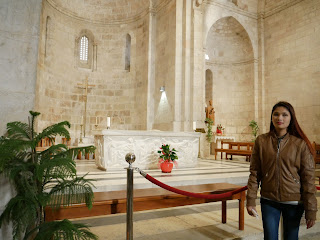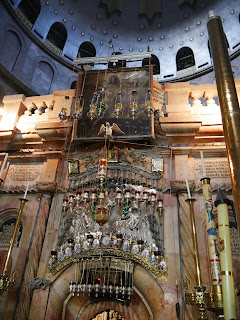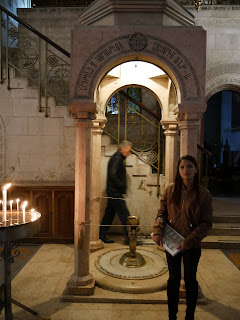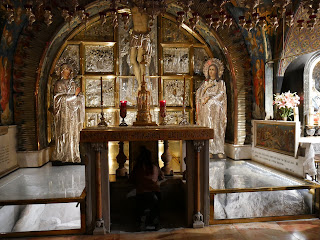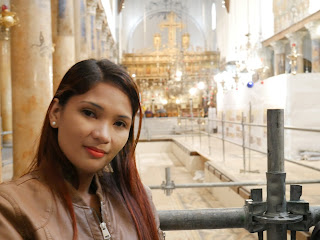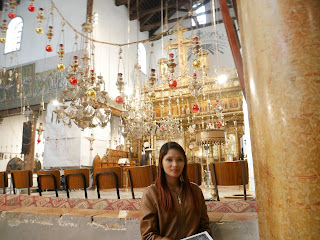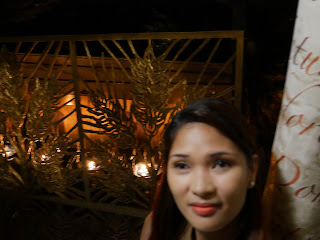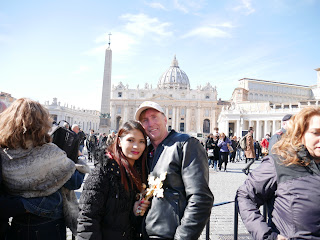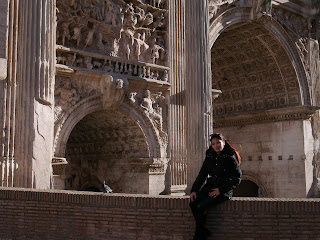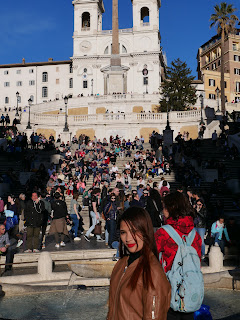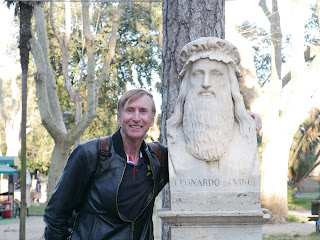pictures from anniversary trip February 20 thru March 1 2019
Picture of the Eastern wall of Jerusalem shows the beautiful Golden color of the wall early morning at sunrise and the golden gate, the only eastern gate that lead to the temple mount, where Christ entered Jerusalem it has been rebuilt in approximately 520 AD opened and resealed by the various rulers of the city but now sealed shut since 1541 (Ezekiel 44:1–3)
The Jaffa Gate was built in July 1548 and the tower of David on the right7th Station on the Via Dolorosa the Gate of Judgment, This is the gate through which Jesus left the city of Jerusalem for his crucifixion outside the city, and here his guilt was proclaimed: He was declared as the King of the Jews According to a later tradition Jesus fell a second time, on the threshold of the gate
The Eighth station commemorates an episode described by the Gospel of Luke, alone among the canonical gospels, in which Jesus encounters pious women on his journey, and is able to stop and give a sermon. However, prior to the 15th century the final station in Jesus' walk was believed to occur at a point earlier on the Via Dolorosa, before this location would have been reached. The present eighth station is adjacent to the Greek Orthodox Monastery of Saint Charalampus; it is marked by the word Nika (a Greek word meaning Victory) carved into the wall, and an embossed cross.
In Jesus’ time, the place where Maica is standing would have been an open field between the city wall and Golgotha, where Jesus was crucified. This is where the women of Jerusalem stood and watched the event. The New Testament recounts: “And there followed him a great multitude of people, and of women who bewailed and lamented him. But Jesus turned unto them and said, Daughters of Jerusalem, weep not for me, but weep for yourselves, and for your children” (Luke 23:27-28)
The entrance to the church of the holy sepulcher In 70 AD, the siege of Jerusalem by Emperor Titus saw the destruction of the Second Temple. Sixty years later, in 130 AD, the Roman emperor Hadrian started a Roman colony in Jerusalem, and in 135, ordered that a cave containing a rock-cut tomb be filled in to create a flat foundation for a temple dedicated to Jupiter or Venus. The temple, usually referred to as Jupiter Capitolinus, remained until the early 4th century
After seeing a vision of a cross in the sky in 312, Constantine the Great converted to Christianity, signed the Edict of Milan legalizing the religion, and sent his mother Helena to Jerusalem to look for Christ's tomb. With the help of Bishop of Caesarea Eusebius and Bishop of Jerusalem Macarius, three crosses were found near a tomb, leading the Romans to believe that they had found Calvary. Constantine ordered in about 326 that Jupiter Capitolinus be replaced by a church. After the temple was torn down and its ruins removed, the soil was removed from the cave, revealing a rock-cut tomb that Helena and Macarius identified as the burial site of Jesus.
mount of olives
where the rocks are from
chapel of the ascension traditionally believe to be the earthly spot where Jesus ascended into Heaven after his resurrection. It houses a slab of stone believed to contain one of his footprints.Shortly after the death and resurrection of Jesus, early Christians began gathering in secret to commemorate his Ascension at a small cave on the Mount of Olives. The issuance of the Edict of Milan by the Roman Emperor Constantine I in 313 made it possible for Christians to worship overtly without fear of government persecution. By the time of the pilgrim Egeria's travels to Jerusalem in 384, the spot of veneration had been moved to the present location, uphill from the cave, which had been integrated into the Constantinian Church of Eleona, dedicated by then just to Jesus' teachings about good and evil (Matthew 24:1-26:2)
Gethsemane
Mark 14
36 Then Jesus went with his disciples to a place called Gethsemane, and he said to them, “Sit here while I go over there and pray.” 37 He took Peter and the two sons of Zebedee along with him, and he began to be sorrowful and troubled. 38 Then he said to them, “My soul is overwhelmed with sorrow to the point of death. Stay here and keep watch with me.”
39 Going a little farther, he fell with his face to the ground and prayed, “My Father, if it is possible, may this cup be taken from me. Yet not as I will, but as you will.”
40 Then he returned to his disciples and found them sleeping. “Couldn’t you men keep watch with me for one hour?” he asked Peter. 41 “Watch and pray so that you will not fall into temptation. The spirit is willing, but the flesh is weak.”
42 He went away a second time and prayed, “My Father, if it is not possible for this cup to be taken away unless I drink it, may your will be done.”
43 When he came back, he again found them sleeping, because their eyes were heavy. 44 So he left them and went away once more and prayed the third time, saying the same thing.
45 Then he returned to the disciples and said to them, “Are you still sleeping and resting? Look, the hour has come, and the Son of Man is delivered into the hands of sinners. 46 Rise! Let us go! Here comes my betrayer!”
several olive trees in the garden are among the oldest known to science. Dates of 1092, 1166 and 1198 AD were obtained by carbon dating from older parts of the trunks of three trees. DNA tests show that the trees were originally planted from the same parent plant. This could indicate an attempt to keep the lineage of an older species intact. Then again, the three trees tested could have been sprouts reviving from the older roots. "The results of tests on trees in the Garden of Gethsemane have not settled the question of whether the gnarled trees are the very same which sheltered Jesus because olive trees can grow back from roots after being cut down", All the tree trunks are hollow inside so that the central, older wood is missing . . . In the end, only three from a total of eight olive trees could be successfully dated. The dated ancient olive trees do, however, not allow any hypothesis to be made with regard to the age of the remaining five giant olive trees. the roots of the oldest trees are possibly much older and then points out the traditional claim that the trees are two thousand years old
Luke 22:40-46
40 When He arrived at the place, He said to them, “Pray that you may not enter into temptation.” 41 And He withdrew from them about a stone’s throw, and He knelt down and began to pray, 42 saying, “Father, if You are willing, remove this cup from Me; yet not My will, but Yours be done.” 43 [a]Now an angel from heaven appeared to Him, strengthening Him. 44 And being in agony He was praying very fervently; and His sweat became like drops of blood, falling down upon the ground. 45 When He rose from prayer, He came to the disciples and found them sleeping from sorrow, 46 and said to them, “Why are you sleeping? Get up and pray that you may not enter into temptation.”
Church of All Nations. Also known as the Basilica of the Agony, as reference to Jesus' night of Passion there.
The church was built by Antonio Barluzzi, the Italian architect, in 1924. The unique design is a harmonious mixture of outstanding Islamic architectural features, like domes on the roof and sides of the building, and christian basilica in the front.
inside Gethsemane Church is the - The stone of Agony where we had a very private Mass in Italian. The stone of agony is a the rock is a circle of thorns made of wrought iron. A mosaic in the apse symbolizes Christ's suffering and being comforted by an angel. More representations of occurrences in Christ's passion, like his arrest and the Kiss of Judas can be seen in the side apses
across the street is a view of a Jewish cemetery with Absalom's Tomb and Zecharias' Tomb a view of the golden eastern wall at sunrise
looking out our window from the Waldorf Astoria Jerusalem
Lobby of the Waldorf Astoria Jerusalem
Tower of David. Herod, who wrestled the power away from the Hasmonean dynasty, added three massive towers to the fortifications in 37–34 BC. He built these at the vulnerable northwest corner of the Western Hill, where the Citadel is now located. His purpose was not only to defend the city, but to safeguard his own royal palace located nearby on Mount Zion. Herod named the tallest of the towers, 44 metres (144 ft) in height, the Phasael in memory of his brother who had committed suicide while in captivity. Another tower was called the Mariamne, named for his second wife whom he had executed and buried in a cave to the west of the tower. He named the third tower the Hippicus after one of his friends. Of the three towers, only the base of one of them survives until today—either the Phasael or, as argued by archaeologist Hillel Geva who excavated the Citadel, the Hippicus Tower. Of the original tower itself (now called the Tower of David), some sixteen courses of the original stone ashlars can still be seen rising from ground level
walkway outside the eastern wall of the old city overlooking parts of Jerusalem
this is inside the Muslim controlled temple mount looking out over the mount of olives. We are not allowed to touch, one of the muslim guards scolded us as I was holding Maica's arm as we walked but two guys can hold hands or arms just makes you wonder whats wrong is holding your wifes arm really so offensive to the muslims also praying is not allowed on the temple mount REALLY
this is the Golden gate from inside the Temple mount
this entrance was suppose to be shut with a gate but the gate was removed and I entered the temple mount from the golden gate
Maica is praying where it is forbidden by the muslims
The Church of Saint Anne The actual Church of St Anne followed sometime between 1131 and 1138, during the reign of Queen Melisende. It was erected near the remains of the Byzantine basilica, over the site of a grotto believed by the Crusaders to be the childhood home of the Virgin Mary, mother of Jesus. It is dedicated to Anna and Joachim, the parents of Saint Mary, who according to tradition lived here.
Unlike many other Crusader churches, St. Anne's was not destroyed after Ṣalāḥ ad-Dīn's 1187 conquest of Jerusalem. In 1192 Ṣalāḥ ad-Dīn, known in the West as Saladin, converted the building into a madrasa (Islamic educational institution), known as al-Madrasa as-Salahiyya (of Saladin), as is still written in the Arabic inscription above the entrance
The three-aisled basilica incorporates cross-vaulted ceilings and pillars, clear clean lines and a somewhat unadorned interior. The nave is separated from the lower lateral aisles by arcades of arches. The high altar, designed by the French sculptor Philippe Kaeppelin incorporates many different scenes. On the front of the altar are depicted the Nativity (left), the Descent from the Cross (center) and the Annunciation (right); on the left-hand end is the teaching of Mary by her mother, on the right-hand end her presentation in the Temple.[4] In the south aisle is a flight of steps leading down to the crypt, in a grotto believed by the Crusaders to be Mary's birthplace. An altar dedicated to Mary is located there. The Byzantine basilica was partly stretched over two water basins, collectively known as the Pools of Bethesda, and built upon a series of piers, one of which still stands today in its entirety.
The church possesses amazing acoustics perfect for Gregorian chant, with sounds moving across the open space and up from the grotto. This makes the church a pilgrimage site for soloists and choirsCurrently St. Anne's belongs to the French government and is administered by the Missionaries of Africa, commonly called "The White Fathers", for the color of their robes
The Pool of Bethesda is a pool of water in the Muslim Quarter of Jerusalem, on the path of the Beth Zeta Valley. It is known from the New Testament story of healing the paralytic at Bethesda, from the fifth chapter of the Gospel of John; the gospel describes a pool in Jerusalem, near the Sheep Gate, which is surrounded by five covered colonnades.
Until the 19th century, there was no evidence outside of John’s Gospel for the existence of this pool; therefore, scholars argued that the gospel was written later, probably by someone without first-hand knowledge of the city of Jerusalem, and that the pool had only a metaphorical, rather than historical, significance. In the 19th century, archaeologists discovered the remains of a pool fitting the description in John’s Gospel.
The biblical narrative continues by describing a Sabbath visit to the site by Jesus, during which he heals a man who has been bedridden for many years, and could not make his own way into the pool.
Stone of Anointing
The Stone of Anointing, where Jesus' body is said to have been anointed before burial
Just inside the entrance to the church is the Stone of Anointing (also Stone of the Anointing or Stone of Unction), which tradition believes to be the spot where Jesus' body was prepared for burial by Joseph of Arimathea.
The lamps that hang over the Stone of Unction, adorned with cross-bearing chain links, are contributed by Armenians, Copts, Greeks and Latins.
According to the New Testament, Jesus was crucified at Golgotha, “the place of the skull” (Matt. 27:33–35; Mark 15:22–25; John 19:17–24). This has been identified as an area of abandoned stone quarries just outside the city wall of the time.
About 10 years after the crucifixion, a third wall was built that enclosed the area of the execution and burial within the city, and this accounts for the Holy Sepulchre’s location inside the Old City of Jerusalem today
Bell tower
The church's bell tower is located to the left of the facade. It is currently almost half its original size.
Facade and entrance
The entrance to the church, a single door in the south transept—through the crusader facade—is found past a group of streets winding through the outer Via Dolorosa, by way of a local souq in the Muristan
The courtyard facing the entrance to the church is known as the parvis. Located around the parvis are a few smaller structures.
South of the parvis, opposite the church:
Broken columns—once forming part of an arcade—stand opposite the church, at the top of a short descending staircase stretching over the entire breadth of the parvis. In the 13th century, the tops of the columns were removed and sent to Mecca by the Khwarezmids
Via Dolorosa10th Station:
Jesus is Stripped of his Garments
Coming into the main square of the Basilica of the Holy Sepulchre, on our right is the steps leading up to the small Franciscan chapel where Jesus was stripped of his clothes.
Catholicon
On the east side opposite the Rotunda is the Crusader structure housing the main altar of the Church, today the Greek Orthodox catholicon. The main dome is 19.8 metres (65 ft) in diameter. The second, smaller dome sits directly over the centre of the transept crossing of the choir where the compas, an omphalos once thought to be the center of the world (associated with the site of the Crucifixion and the Resurrection), is situated
The rotunda is located in the center of the Anastasis, beneath the larger of the church's two domes. In the center of the rotunda is a small chapel called the Kouvouklion in Greek or the Aedicula in Latin, which encloses the Holy Sepulchre. The Aedicule has two rooms, the first holding the Angel's Stone, which is believed to be a fragment of the large stone that sealed the tomb; the second is the tomb itself. Possibly due to the fact that pilgrims laid their hands on the tomb or to prevent eager pilgrims from removing bits of the original rock as souvenirs, a marble plaque was placed in the fourteenth century on the tomb to prevent further damage to the tomb
Via Dolorosa 14th Station:
Jesus is Laid in the Tomb
Returning to the ground level, the 14th station can be found in the rotunda of the basilica. This spot is generally accepted as the place of Christ's burial by most churches.
this is the chapel of the 3 Mary's or the Armenian chapel of the Holy Women commemorates where Mary (mother of Jesus), Mary Magdalene, and Mary of Clopas watched the crucifixion inside the Church of Holy Sepulchre
Station 13 of Via Dolorosa Jesus of Nazareth died on the cross for the sins of others. The earth shook, a the rain started pouring, and the crowd disappeared. Just the immediately family and some friends remained over here as Jesus was up on the cross. Joseph of Arimathea, and Nicodemus, realized the importance of the moment asking Pontius Pilate to give the body of Jesus, Nicodemus and joseph of Arimathea gave the note to the centurions, and Jesus of Nazareth was taken down from the cross and laid on this stone. He will be immediately cleaned and covered with shrouds. But because we are on a Friday afternoon and the sun is almost setting in the west, sabbath will start when they can not prepair the body by Jewish laws. Joseph of Arimathea comes up with a solution. “mother Mary,” he says, “I cannot bring your son back.” “but if you will allow me I will secure his honor by giving him my tomb,” who is standing not far away. Jesus of Nazareth will be taken from this stone into the tomb of joseph Arimathea. the tomb will be sealed by a rolling stone, the temple horn is calling for the sabbath has entered. Jesus is saved. because of the fact that Jesus’s body has laid on that particular stone anything that touches it is said, becomes automatically a third-level relic
Within the Church of the Holy Sepulchre, the Chapel of Adam sits directly under the rock of Golgotha. The Chapel is maintained by the Greek Orthodox Church.
the Chapel of Adam, is an unadorned chapel that sits back in an alcove. A short wall that has four posts with red marble between them. The marble is inlaid with a white square. The doorway is covered by a set of wooden doors that rise to meet at a point. An extremely simple altar has nothing on it. A single lamp hangs from the ceiling. nothing is on the walls except one unexpected feature. Cut into the back wall of the chapel is a window that is covered by glass. Through the glass can be seen a part of the rock that is known as Golgotha. Since this chapel sits directly under where Jesus was crucified, the rock that is exposed through the opening is the lower part of the same rock.
Matthew 27: 50 Jesus, when he had cried again with a loud voice, yielded up the ghost.
51 And, behold, the veil of the temple was rent in twain from the top to the bottom; and the earth did quake, and the rocks rent;
52 And the graves were opened; and many bodies of the saints which slept arose,
53 And came out of the graves after his resurrection, and went into the holy city, and appeared unto many
When Jesus died on the cross on the rock above this chapel, the veil in the temple was torn from top to bottom, an earthquake hit, and rocks were split. Looking through the window in the Chapel of Adam is believed to be one of those places where the rock split.
Some churches says that the placement of this Chapel of Adam is significant. Tradition holds that this is where Adam was buried and the when the blood of Jesus was spilled on the cross, and when the rocks were split from the earthquake, that the blood of Jesus ran down to where Adam had been buried. This brought the salvation of God through the blood of Jesus to Adam and symbolically to all those who preceded Christ in the Old Testament. The separation from God that had come from Adam and Eve’s sin in the garden when they ate from the tree that God had instructed them not to eat from had the possibility now to be removed. With the forgiveness of sin, Adam could be reconciled back to the Father through the blood of Jesus. Through the cross, Jesus spanned the chasm of separation that was there because of sin and made it possible for the relationship between God and man to be restored.
Via Dolorosa 12th Station:
Jesus Dies on the Cross
In the Greek Orthodox chapel, also in the Church of the Holy Sepulchre, is the place of Christ's death on Calvary. A fissure in the rock displays the damage caused by the earthquake that followed Christ's death
Rock of Calvary
Next to the Chapel of Adam directly beneath the Chapel of Calvary upstairs, and an ancient tradition suggests that Adam was buried here and that the blood of Jesus tricked down to his skull.
Here the rock of Calvary can be seen, with a fissure running through it. Some believe the fissure was caused by the earthquake at the time Christ died
In the Holy Sepulchre, the Chapel of Derision a Greek Orthodox chapel. Underneath the altar, encased in a glass enclosure is a fragment of a column that is believed to be the place where Jesus sat as they placed the crown of thorns on His head and beat it on with a stick.
The emphasis in this chapel is the way that Jesus was mocked and ridiculed. Jesus took verbal abuse from the Jews, and from the Romans. So, while bearing the physical abuse of the beating and the cross, He was also mocked by the people and those in authority.
The Chapel of Derision reminds the worshipper of all that Jesus went through by being scorned and rejected by the very people He came to save. Rather than embracing the Messiah, the Jews and the Romans rejected Him.
It is said that anyone who puts an ear to the altar in the Chapel of Derision will hear the sounds of laughter representing those who laughed at Jesus.
in the Church of the Holy Sepulchre, a hallway from the Crusader era along the eastern side is the Chapel of the Division of the Raiment which is an Armenian chapel. This chapel recalls that the soldiers drew lots, rather than tearing the cloth, to see who would keep the garments of Jesus Christ.
The Chapel of the Division of the Raiment signifies an important part of the crucifixion. Psalms 22:18 prophesied that the clothing of the Messiah would be divided up with those receiving the clothing casting lots to see who would get what piece of clothing. According to John 19:24, that is exactly what the soldiers crucifying Jesus did.
Chapel of Saint Longinus: Longinus is thought to have been the Roman centurion who said
In truth this man was son of God. (Matthew 27:54)
Steps up from Chapel of St Helena and Chapel of the Finding of the Cross
Via Dolorosa 11th Station:
Jesus is Nailed to the Cross
Within the Latin chapel in the Church of the Holy Sepulchre, the 11th station houses modern mosaics that illustrate Jesus being nailed to the cross.
The Western Wall is considered holy due to its connection to the Temple Mount. Because of the Temple Mount entry restrictions, the Wall is the holiest place where Jews are permitted to pray, though the holiest site in the Jewish faith lies behind it. The original, natural, and irregular-shaped Temple Mount was gradually extended to allow for an ever-larger Temple compound to be built at its top. This process was finalized by Herod, who enclosed the Mount with an almost rectangular set of retaining walls, built to support extensive substructures and earth fills needed to give the natural hill a geometrically regular shape. On top of this box-like structure Herod built a vast paved esplanade which surrounded the Temple. Of the four retaining walls, the western one is considered to be closest to the former Temple, which makes it the most sacred site recognized by Judaism outside the former Temple Mount
Herod's Temple was destroyed by the Romans, along with the rest of Jerusalem, in 70 CE, during the First Jewish–Roman War.
Via Dolorosa fifth station refers to the biblical episode in which Simon of Cyrene takes Jesus' cross, and carries it for him. Although this narrative is included in the three Synoptic Gospels, the Gospel of John does not mention Simon of Cyrene but instead emphasizes the portion of the journey during which Jesus carried the cross himself. The current traditional site for the station is located at the east end of the western fraction of the Via Dolorosa, adjacent to the Chapel of Simon of Cyrene, a Franciscan construction built in 1895. An inscription, in the architrave of one of the Chapel doors, references the Synoptic events
Via Dolorosa Third Station:
Jesus Falls the First Time
Though not mentioned in the Gospels, it is believed Jesus fell near the ancient Fish Gate
Via Dolorosa Fourth Station:
Jesus Meets his Afflicted Mother
An image of Jesus meeting his mother with the cross appears on the doorway of a small chapel to mark this station. This event is also not mentioned in the Bible.
Via Dolorosa fourth station
The New Testament makes no mention of a meeting between Jesus and his mother, during the walk to his crucifixion, but popular tradition introduces one. The fourth station, the location of a 19th-century Armenian Catholic oratory, commemorates the events of this tradition; a lunette, over the entrance to the chapel, references these events by means of a bas-relief carved by the Polish artist Zieliensky. The oratory, named Our Lady of the Spasm, was built in 1881, but its crypt preserves some archaeological remains from former Byzantine buildings on the site, including a mosaic floor.
The northern opening of the Ecce Homo arch second arch in background According to tradition, this is the site Pilate presented Jesus to the crowds (John 19 5): "Then came Jesus forth, wearing the crown of thorns, and the purple robe. And Pilate saith unto them, Behold the man!".
Via Dolorosa First Station:
Pilate Condemns Jesus to Die
This station begins in the courtyard of the Omariya Moslem College a muslim school on the street called the Via Dolorosa. This is the traditional location of the Praetorium of Pilate and the Lithostrotos, the place where Jesus was scourged, condemned and where he received his crown of thorns however christians can not enter as it is muslim school maybe Christians should invade Mecca steel many of there holy relics and not allow the musilms in like they do to the Jews and Christians
Via Dolorosa Station 2
Jesus receives His Cross
The second station is located near the compound of the Franciscan monastery, across the street from the first station. At this station Jesus receives the cross (John 19:17, 19): "And he bearing his cross went forth into a place called the place of a skull, which is called in the Hebrew Golgotha...And Pilate wrote a title, and put it on the cross.
Via Dolorosa Fifth Station:
Simon Helps Carry the Cross
A small chapel was built in 1895 and dedicated to Simon of Cyrene to mark the fifth station
Via Dolorosa Eighth Station:
Jesus Speaks to Women of Jerusalem
To the right is a Latin cross and the letters "NIKA" which means "Jesus Christ conquers," is carved into the wall of the Greek Orthodox Convent of St. Charalambos.
Bethlehem, Israel
Armenian monastery (right) and facade of the Church of the Nativity (center)
The church was originally commissioned in 327 by Constantine the Great and his mother Helena on the site that was traditionally considered to be the birthplace of Jesus. That original basilica was completed sometime between 333-339. It was destroyed by fire during the Samaritan revolts of the 6th century, and a new basilica was built in 565 by Byzantine Emperor Justinian, who restored the architectural tone of the origina
The holy site known as the Nativity Grotto is thought to be the cave in which Jesus of Nazareth was born. In 135, Emperor Hadrian had the site above the Grotto converted into a worship place for Adonis, the Greek god of beauty and desire.Jerome noted in 420 that the grotto had been consecrated to the worship of Adonis, and that a sacred grove was planted there in order to completely wipe out the memory of Jesus from the world
The Grotto of the Nativity, the place where Jesus is said to have been born, is an underground space which forms the crypt of the Church of the Nativity. It is situated underneath its main altar, and it is normally accessed by two staircases on either side of the chancel. The Grotto is part of a network of caves, which are accessed from the adjacent Church St Catherine's. The tunnel-like corridor connecting the Grotto to the other caves is normally locked.
The cave has an eastern niche said to be the place where Jesus was born, which contains the Altar of Nativity. The exact spot where Jesus was born is marked beneath this altar by a 14-pointed silver star with the Latin inscription Hic De Virgine Maria Jesus Christus Natus Est-1717 (Here Jesus Christ was born to the Virgin Mary-1717). It was installed by the Catholics in 1717, removed - allegedly by the Greeks - in 1847, and replaced by the Turkish government in 1853. The star is set into the marble floor and surrounded by 15 silver lamps representing the three Christian communities: six belong to the Greek Orthodox, four to the Catholics, and five to the Armenian Apostolic. The Altar of the Nativity is maintained by the Greek Orthodox and Armenian Apostolic churches.
Roman Catholics are in charge of a section of the Grotto known as the "Grotto of the Manger", marking the traditional site where Mary laid the newborn Baby in the manger. The Altar of the Magi is located directly opposite from the manger site
an early Christian theologian and Greek philosopher Origen of Alexandria (185–c. 254) wrote:
In Bethlehem the cave is pointed out where He was born, and the manger in the cave where He was wrapped in swaddling clothes. And the rumor is in those places, and among foreigners of the Faith, that indeed Jesus was born in this cave who is worshiped and reverenced by the Christian
The Church of the Nativity, also Basilica of the Nativity is a basilica located in Bethlehem in the West Bank. The grotto it contains holds a prominent religious significance to Christians of various denominations as the birthplace of Jesus. The grotto is the oldest site continuously used as a place of worship in Christianity, and the basilica is the oldest major church in the Holy Land
bus back to Jerusalem


The Garden Tomb is a rock-cut tomb in Jerusalem, which was unearthed in 1867 and is considered by some Christians to be the site of the burial and resurrection of Jesus
The Church of the Holy Sepulchre has the tomb just a few yards away from Golgotha, corresponding with the account of John the Evangelist: "Now in the place where he was crucified there was a garden; and in the garden a new sepulchre, wherein was never man yet laid." KJV (John 19:41). In the latter half of the 19th century a number of tombs had also been found near Gordon's Golgotha, and Gordon concluded that one of them must have been the tomb of Jesus. John also specifies that Jesus' tomb was located in a garden; consequently, an ancient wine press and cistern have been cited as evidence that the area had once been a garden, and the somewhat isolated tomb adjacent to the cistern has become identified as the Garden Tomb of Jesus. This particular tomb also has a stone groove running along the ground outside it, which Gordon argued to be a slot that once housed a stone, corresponding to the biblical account of a stone being rolled over the tomb entrance to close it.
The Garden Tomb is adjacent to a rocky escarpment which since the mid-nineteenth century has been proposed by some scholars to be Golgotha. It has since been known as Skull Hill or Gordon's Golgotha. In contradistinction to this modern identification, the traditional site where the death and resurrection of Christ are believed to have occurred has been the Church of the Holy Sepulchre at least since the fourth century.
flight to Rome
our apartment in Rome was overlooking this Pizia
The Pantheon "temple of all the gods" is a former Roman temple, now a church, in Rome, Italy, on the site of an earlier temple commissioned by Marcus Agrippa during the reign of Augustus (27 BC – 14 AD). It was completed by the emperor Hadrian and probably dedicated about 126 AD. Its date of construction is uncertain, because Hadrian chose not to inscribe the new temple but rather to retain the inscription of Agrippa's older temple, which had burned down.
Sunday our first day in Rome we went to the Popes Mass
The Mausoleum of Hadrian, usually known as Castel Sant'Angelo ( English: Castle of the Holy Angel), is a towering cylindrical building in Parco Adriano, Rome, Italy. It was initially commissioned by the Roman Emperor Hadrian as a mausoleum for himself and his family. The building was later used by the popes as a fortress and castle, and is now a museum
Ponte Umberto I, also known as Ponte Umberto, is a bridge that links Piazza di Ponte Umberto I to Piazza dei Tribunali in Rome
first real Italian food
The Vittorio Emanuele II Monument, also known as the (Mole del) Vittoriano, Il Vittoriano, or Altare della Patria (English: "Altar of the Fatherland"), is a monument built in honor of Victor Emmanuel II, the first king of a unified Italy
Construction began under the emperor Vespasian in AD 72, and was completed in AD 80 under his successor and heir Titus



Vatican Museum
Colosseum
Arch of Constantine
House of the Vestals
Casa delle Vestali
Orti Farnesiani sul Palatino
Domus Augustana on Palatine Hill
Il Tempio dei Dioscuri
The Spanish Steps, climbing a steep slope between the Piazza di Spagna at the base and Piazza Trinità dei Monti, dominated by the Trinità dei Monti church at the top
Faro del Gianicolo
Il muro della Costituzione Romana
Fontana dell'Acqua Paola
Mausoleo Ossario Garibaldino
Ponte Fabricio
The Theatre of Marcellus is an ancient open-air theater in Rome, Italy, built in the closing years of the Roman Republic. At the theatre, locals and visitors alike were able to watch performances of drama and song. Today its ancient edifice in the rione of Sant'Angelo, Rome, once again provides one of the city's many popular spectacles or tourist sites. Space for the theater was cleared by Julius Caesar, who was murdered before its construction could begin; the theater was advanced enough by 17 BC that part of the celebration of the ludi saeculares took place within the theater; it was completed in 13 BC and formally inaugurated in 12 BC by Augustus.
The theater was 111 m in diameter and was the largest and most important theater in Ancient Rome; it could originally hold between 11,000 and 20,000 spectators.
our anniversary dinner at L'arcano S.r.l., Via delle Paste, Rome
Subscribe to:
Comments (Atom)



































































